A Real-Time Intelligent Valve Monitoring Approach through Cameras Based on Computer Vision Methods
Abstract
1. Introduction
2. Methods
2.1. Framework
2.2. Dataset Process
2.3. Valve Feature Extraction by YOLO V8
2.3.1. Feature Extraction
2.3.2. Feature Enhancement
2.3.3. Feature Fusion and Prediction
2.4. Valve Position Calculation
3. Experiments
3.1. Experiment Design
- (1)
- The camera perspective was set diagonally above the experimental equipment, simulating an industrial surveillance scenario.
- (2)
- The experimental scenario incorporated valves of different types, primarily with varying exterior appearances.
- (3)
- Scenarios were designed to assess the impact of different lighting conditions on detection.
- (4)
- Scenarios were also created to investigate the effects of valve obstruction on detection.
3.2. Dataset
3.3. Model Training
4. Result and Analysis
4.1. Model Evaluation Criteria
4.2. Results of Valves under Normal Conditions
4.3. Experiment under Obscured Conditions
4.4. Model Evaluation Criteria
4.5. Results Comparison
4.6. Discussion and Prospects
5. Conclusions
- (1)
- A real-time intelligent valve monitoring approach based on computer vision is introduced, incorporating the CA attention mechanism into the YOLOv8 framework to accommodate the characteristics of production scenarios.
- (2)
- The model has been extensively tested on various types of valves, demonstrating its reliability across most prevalent valve types currently in use.
- (3)
- Effective strategies are proposed and experimentally validated to manage scenarios involving obscured valves and varying lighting conditions.
Author Contributions
Funding
Institutional Review Board Statement
Informed Consent Statement
Data Availability Statement
Acknowledgments
Conflicts of Interest
References
- Sotoodeh, K.; Gudmestad, O.T. Safety and reliability improvement of valves and actuators in the offshore oil and gas industry. Life Cycle Reliab. Saf. Eng. 2022, 11, 293–302. [Google Scholar] [CrossRef]
- Yu, J.; Yi, J.; Mahgerefteh, H. Optimal emergency shutdown valve configuration for pressurised pipelines. Process Saf. Environ. Prot. 2022, 159, 768–778. [Google Scholar] [CrossRef]
- Wang, B.; Li, D.; Wu, C. Characteristics of hazardous chemical accidents during hot season in China from 1989 to 2019: A statistical investigation. Saf. Sci. 2020, 129, 104788. [Google Scholar] [CrossRef]
- Megaraj, M.; Dillibabu, S.P.; Durvasulu, R.; Manjunathan, K.; Palanivel, A.; Vasudevan, B.; Grace, N. Post lockdown industrial accidents and their safety ontology. In AIP Conference Proceedings; AIP Publishing: Long Island, NY, USA, 2023. [Google Scholar]
- Sun, F.; Xu, H.; Meng, Y.; Yin, H. A novel multi-view enhanced visual detection for cavitation of control valve. Chem. Eng. Res. Des. 2023, 195, 673–681. [Google Scholar] [CrossRef]
- Memarian, A.; Damarla, S.K.; Huang, B. Control valve stiction detection using Markov transition field and deep convolutional neural network. Can. J. Chem. Eng. 2023, 101, 6114–6125. [Google Scholar] [CrossRef]
- Akavalappil, V.; Radhakrishnan, T.K.; Dave, S.K. A convolutional neural network (CNN)-based direct method to detect stiction in control valves. Can. J. Chem. Eng. 2023, 101, 3963–3981. [Google Scholar] [CrossRef]
- Cao, J.; Zhang, J.; Yu, X.; Tu, S.-T. Detection of pressure relief valve leakage by tuning generated sound characteristics. Process Saf. Environ. Prot. 2021, 148, 664–675. [Google Scholar] [CrossRef]
- Hou, J.J.; Li, S.X.; Yang, L.X.; Zhang, X.D.; Zhao, Q. Multi-leakage source localization of safety valve based on improved KDE algorithm. Process Saf. Environ. Prot. 2023, 171, 493–506. [Google Scholar] [CrossRef]
- Liu, M.; Lang, X.; Li, S.; Deng, L.; Peng, B.; Wu, Y.; Zhou, X. Improved machine learning leak fault recognition for low-pressure natural gas valve. Process Saf. Environ. Prot. 2023, 178, 947–958. [Google Scholar] [CrossRef]
- Ye, G.-Y.; Xu, K.-J.; Wu, W.-K. Multivariable modeling of valve inner leakage acoustic emission signal based on Gaussian process. Mech. Syst. Signal Process. 2020, 140, 106675. [Google Scholar] [CrossRef]
- Peyvan, D.; Buchmann, B. Precision in valve position indication. Nucl. Eng. Int. 2001, 46, 28–29. [Google Scholar]
- Bacci di Capaci, R.; Scali, C. Stiction Quantification: A Robust Methodology for Valve Monitoring and Maintenance Scheduling. Ind. Eng. Chem. Res. 2014, 53, 7507–7516. [Google Scholar] [CrossRef]
- Aranha, P.E.; Lopes, L.; Paranhos Sobrinho, E.; Oliveira, I.d.M.N.; de Araújo, J.; Santos, B.B.d.; Lima Junior, E.; da Silva, T.; Vieira, T.; Lira, W.W.M. A System to Detect Oilwell Anomalies Using Deep Learning and Decision Diagram Dual Approach. SPE J. 2024, 29, 1540–1553. [Google Scholar] [CrossRef]
- Liu, J.; Yuan, C.; Matias, L.; Bowen, C.; Dhokia, V.; Pan, M.; Roscow, J. Sensor Technologies for Hydraulic Valve and System Performance Monitoring: Challenges and Perspectives. Adv. Sens. Res. 2024, 3, 2300130. [Google Scholar] [CrossRef]
- Venkatasubramanian, V. The promise of artificial intelligence in chemical engineering: Is it here, finally? Aiche J. 2019, 65, 466–478. [Google Scholar] [CrossRef]
- Arunthavanathan, R.; Sajid, Z.; Amin, M.T.; Tian, Y.; Khan, F.; Pistikopoulos, E. Process safety 4.0: Artificial intelligence or intelligence augmentation for safer process operation? Aiche J. 2024, 70, e18475. [Google Scholar] [CrossRef]
- Dai, Y.; Wang, H.; Khan, F.; Zhao, J. Abnormal situation management for smart chemical process operation. Curr. Opin. Chem. Eng. 2016, 14, 49–55. [Google Scholar] [CrossRef]
- Krizhevsky, A.; Sutskever, I.; Hinton, G.E. ImageNet Classification with Deep Convolutional Neural Networks. Commun. ACM 2017, 60, 84–90. [Google Scholar] [CrossRef]
- Wu, H.; Wu, D.; Zhao, J. An intelligent fire detection approach through cameras based on computer vision methods. Process Saf. Environ. Prot. 2019, 127, 245–256. [Google Scholar] [CrossRef]
- Huang, P.; Chen, M.; Chen, K.; Zhang, H.; Yu, L.; Liu, C. A combined real-time intelligent fire detection and forecasting approach through cameras based on computer vision method. Process Saf. Environ. Prot. 2022, 164, 629–638. [Google Scholar] [CrossRef]
- Mun, J.; Kim, J.; Do, Y.; Kim, H.; Lee, C.; Jeong, J. Design and Implementation of Defect Detection System Based on YOLOv5-CBAM for Lead Tabs in Secondary Battery Manufacturing. Processes 2023, 11, 2751. [Google Scholar] [CrossRef]
- Zhou, H.; Cong, H.; Wang, Y.; Dou, Z. A computer-vision-based deep learning model of smoke diffusion. Process Saf. Environ. Prot. 2024, 187, 721–735. [Google Scholar] [CrossRef]
- Zhang, P.; Song, Z.; Li, C.; Liu, Y.; Zou, Y.; Zhang, Y.; Sun, P. A study of engine room smoke detection based on proactive machine vision model for intelligent ship. Expert Syst. Appl. 2024, 241, 122689. [Google Scholar] [CrossRef]
- Wang, X.; Wang, J.; Chen, L.; Zhang, Y. Improving Computer Vision-Based Wildfire Smoke Detection by Combining SE-ResNet with SVM. Processes 2024, 12, 747. [Google Scholar] [CrossRef]
- Hu, S.; Feng, A.; Shi, J.; Li, J.; Khan, F.; Zhu, H.; Chen, J.; Chen, G. Underwater gas leak detection using an autonomous underwater vehicle (robotic fish). Process Saf. Environ. Prot. 2022, 167, 89–96. [Google Scholar] [CrossRef]
- Shi, J.; Chang, Y.; Xu, C.; Khan, F.; Chen, G.; Li, C. Real-time leak detection using an infrared camera and Faster R-CNN technique. Comput. Chem. Eng. 2020, 135, 106780. [Google Scholar] [CrossRef]
- Song, Y.; Li, S. Gas leak detection in galvanised steel pipe with internal flow noise using convolutional neural network. Process Saf. Environ. Prot. 2021, 146, 736–744. [Google Scholar] [CrossRef]
- Wang, L.; Zhang, X.; Yang, H. Safety Helmet Wearing Detection Model Based on Improved YOLO-M. IEEE Access 2023, 11, 26247–26257. [Google Scholar] [CrossRef]
- Wu, H.; Zhao, J. An intelligent vision-based approach for helmet identification for work safety. Comput. Ind. 2018, 100, 267–277. [Google Scholar] [CrossRef]
- Hayat, A.; Morgado-Dias, F. Deep Learning-Based Automatic Safety Helmet Detection System for Construction Safety. Appl. Sci. 2022, 12, 8268. [Google Scholar] [CrossRef]
- Li, D.; Ye, Z.; Tang, J.; Wang, X. Visual measurement of valve opening area with improved subpixel edge location. Measurement 2022, 198, 111410. [Google Scholar] [CrossRef]
- Ahmed, M.F.; Hasan, M.K.; Chowdhury, M.Z.; Hoan, N.C.; Jang, Y.M. Continuous Status Monitoring of Industrial Valve Using OCC-Enabled Wireless Sensor Network. IEEE Trans. Instrum. Meas. 2022, 71, 5501010. [Google Scholar] [CrossRef]
- Xu, Z.; Li, T.; Deng, H. Research and application of cone valve seal detection algorithm based on yolov3. Proc. SPIE 2023, 12462, 650–656. [Google Scholar] [CrossRef]
- Qin, R.; Hua, Z.; Sun, Z.; He, R. Recognition method of knob gear in substation based on YOLOv4 and Darknet53-DUC-DSNT. Sensors 2022, 22, 4722. [Google Scholar] [CrossRef]
- Sun, Z.; Cui, Y.; Han, Y.; Jiang, K. Substation High-Voltage Switchgear Detection Based on Improved EfficientNet-YOLOv5s Model. IEEE Access 2024, 12, 60015–60027. [Google Scholar] [CrossRef]
- Wu, Z.; Tohti, G.; Geni, M.; He, H.; Turhun, F. Wind turbine rotor blade encoding marker recognition method based on improved YOLOv8 model. Signal Image Video Process. 2024, 1–12. [Google Scholar] [CrossRef]
- Hou, Q.; Zhou, D.; Feng, J. Coordinate attention for efficient mobile network design. In Proceedings of the IEEE/CVF Conference on Computer Vision and Pattern Recognition, Nashville, TN, USA, 19–25 June 2021; pp. 13713–13722. [Google Scholar]
- Murrugarra-Llerena, J.; Kirsten, L.N.; Zeni, L.F.; Jung, C.R. Probabilistic Intersection-Over-Union for Training and Evaluation of Oriented Object Detectors. IEEE Trans. Image Process. 2024, 33, 671–681. [Google Scholar] [CrossRef] [PubMed]
- Li, X.; Wang, W.; Wu, L.; Chen, S.; Hu, X.; Li, J.; Tang, J.; Yang, J. Generalized focal loss: Learning qualified and distributed bounding boxes for dense object detection. Adv. Neural Inf. Process. Syst. 2020, 33, 21002–21012. [Google Scholar]
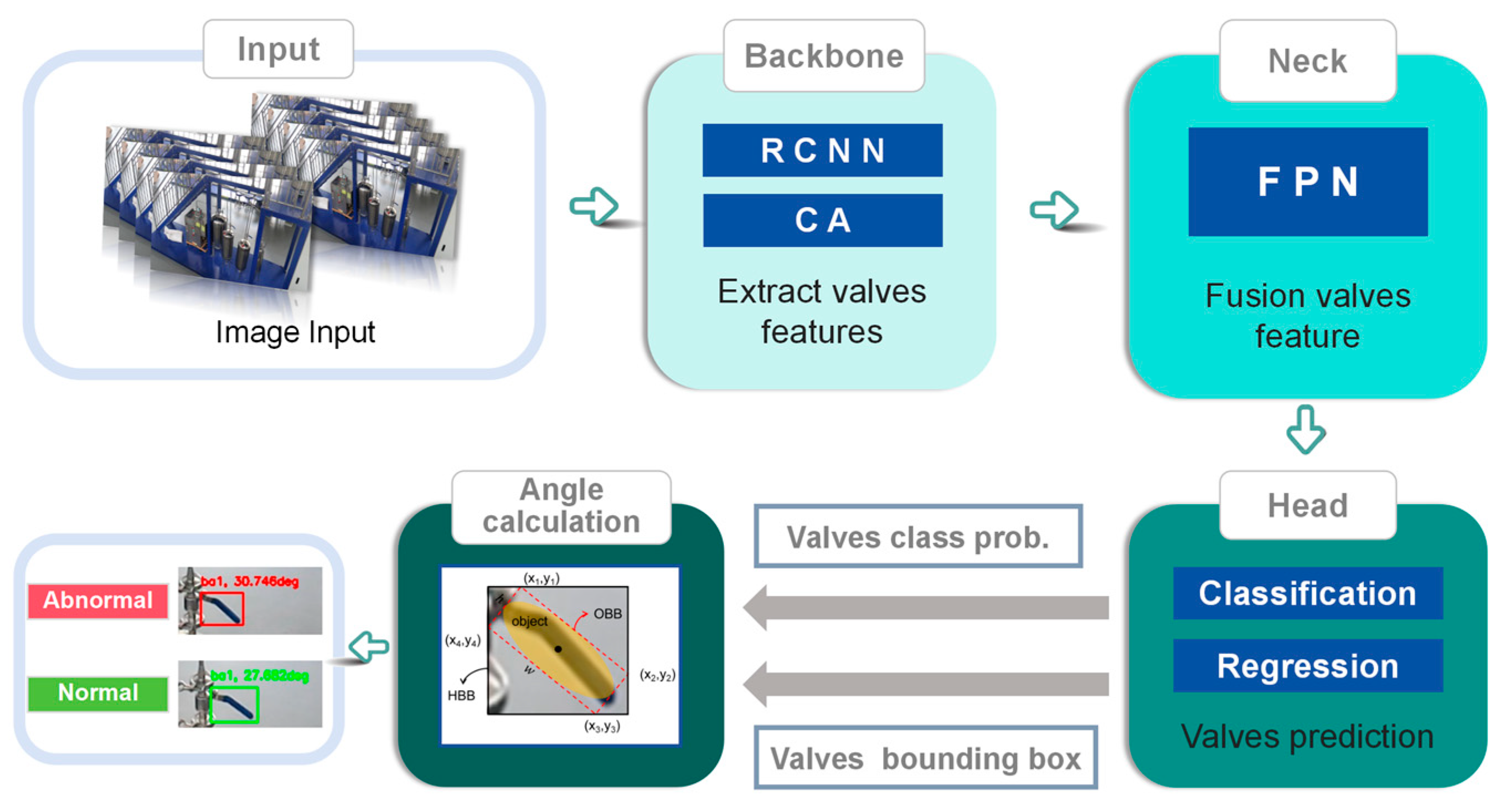









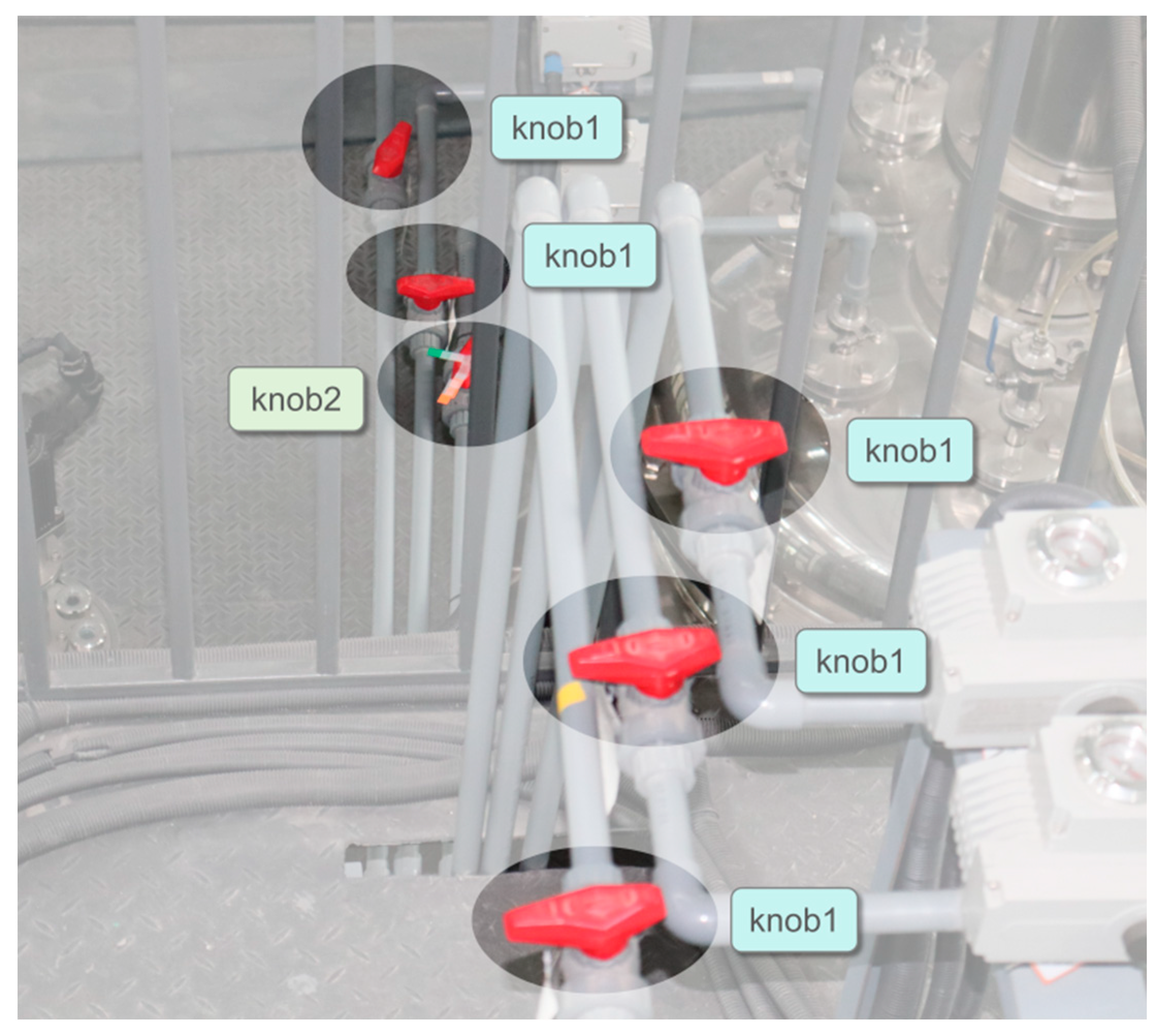
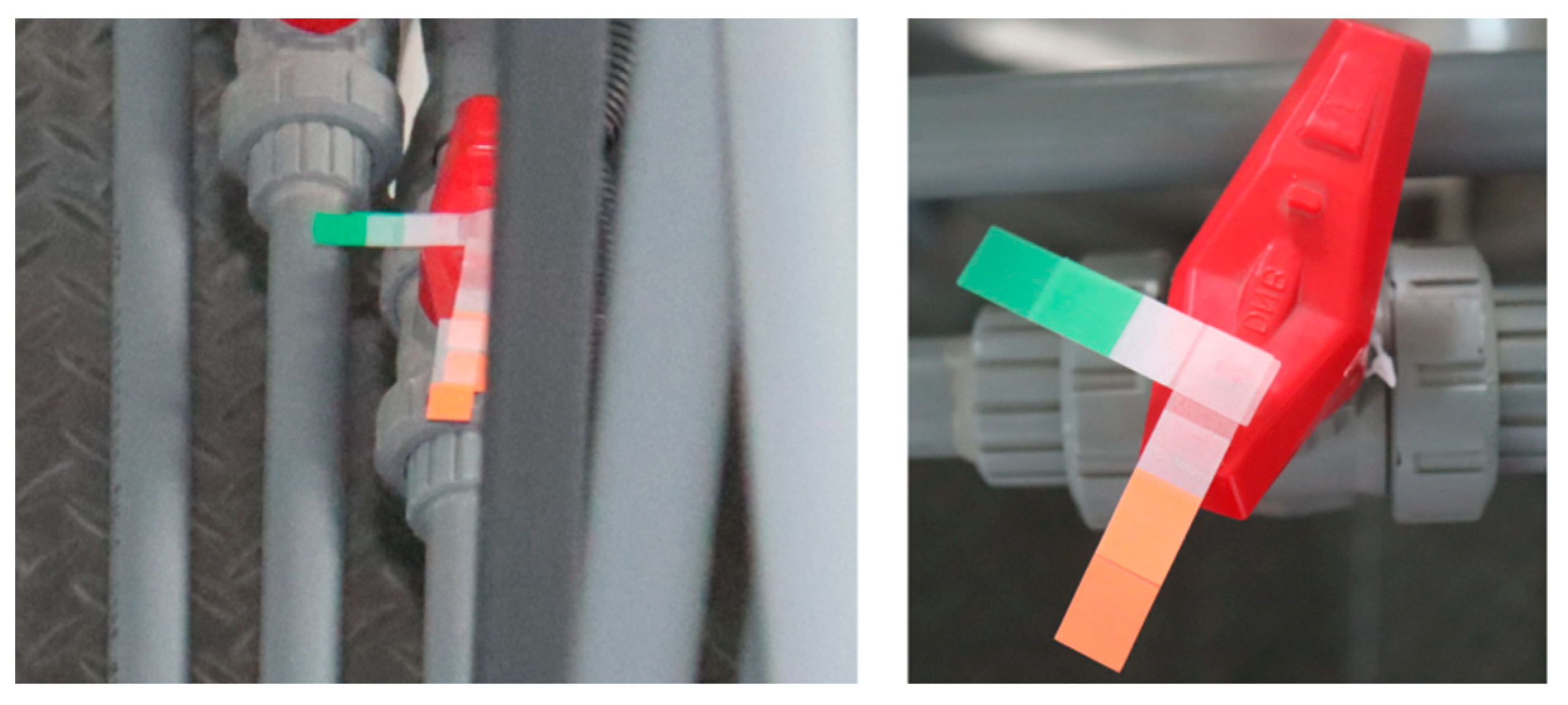
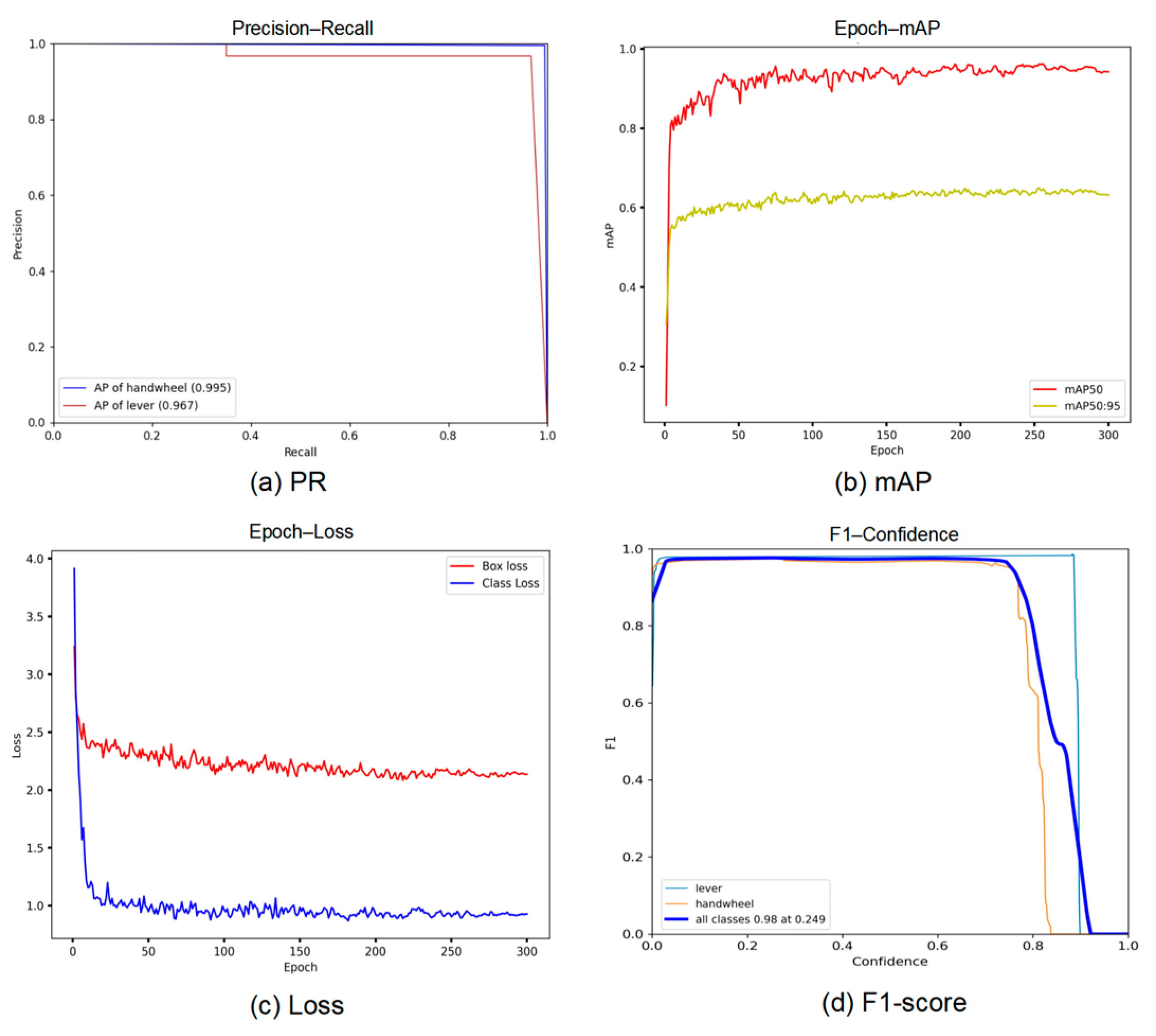


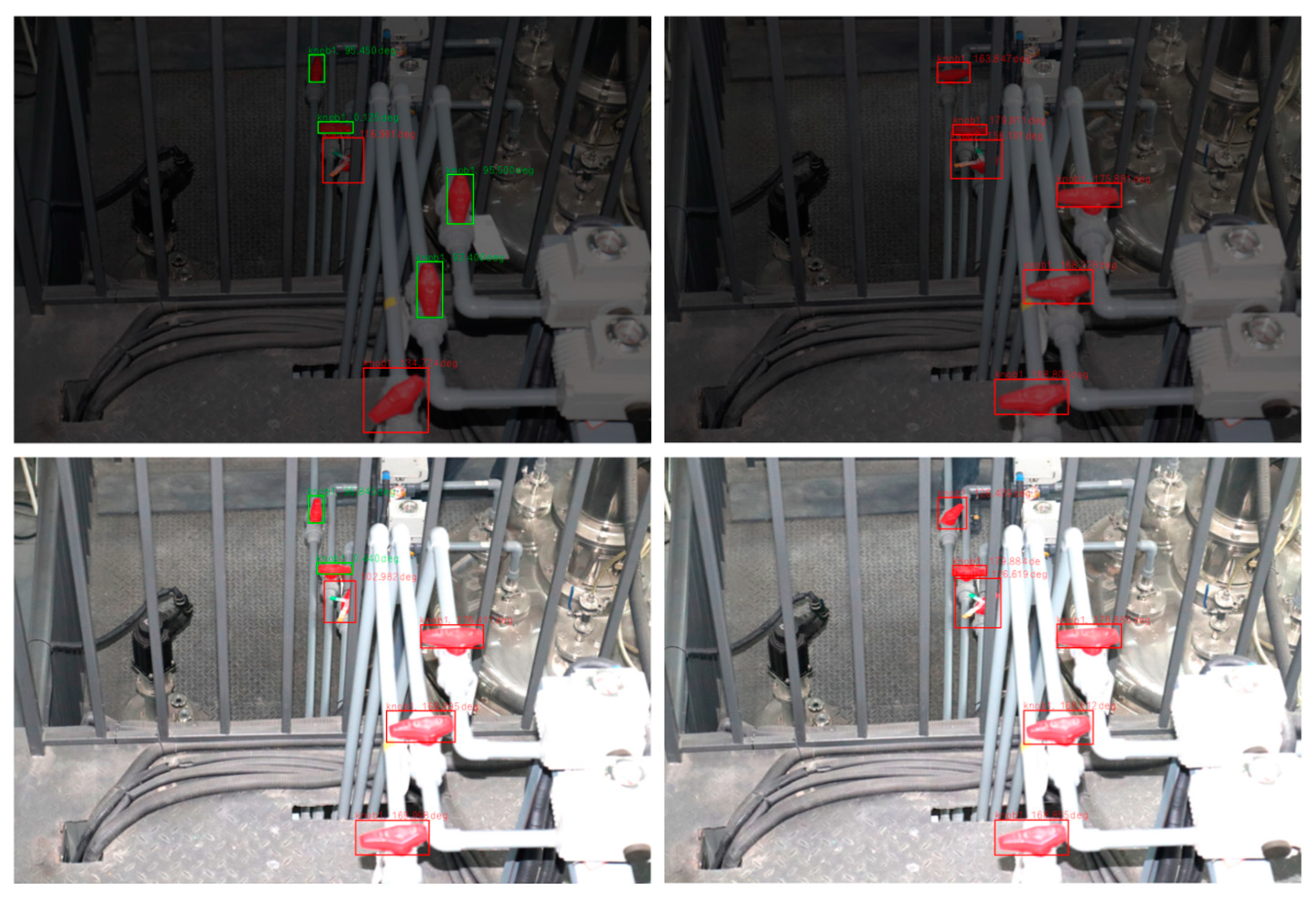
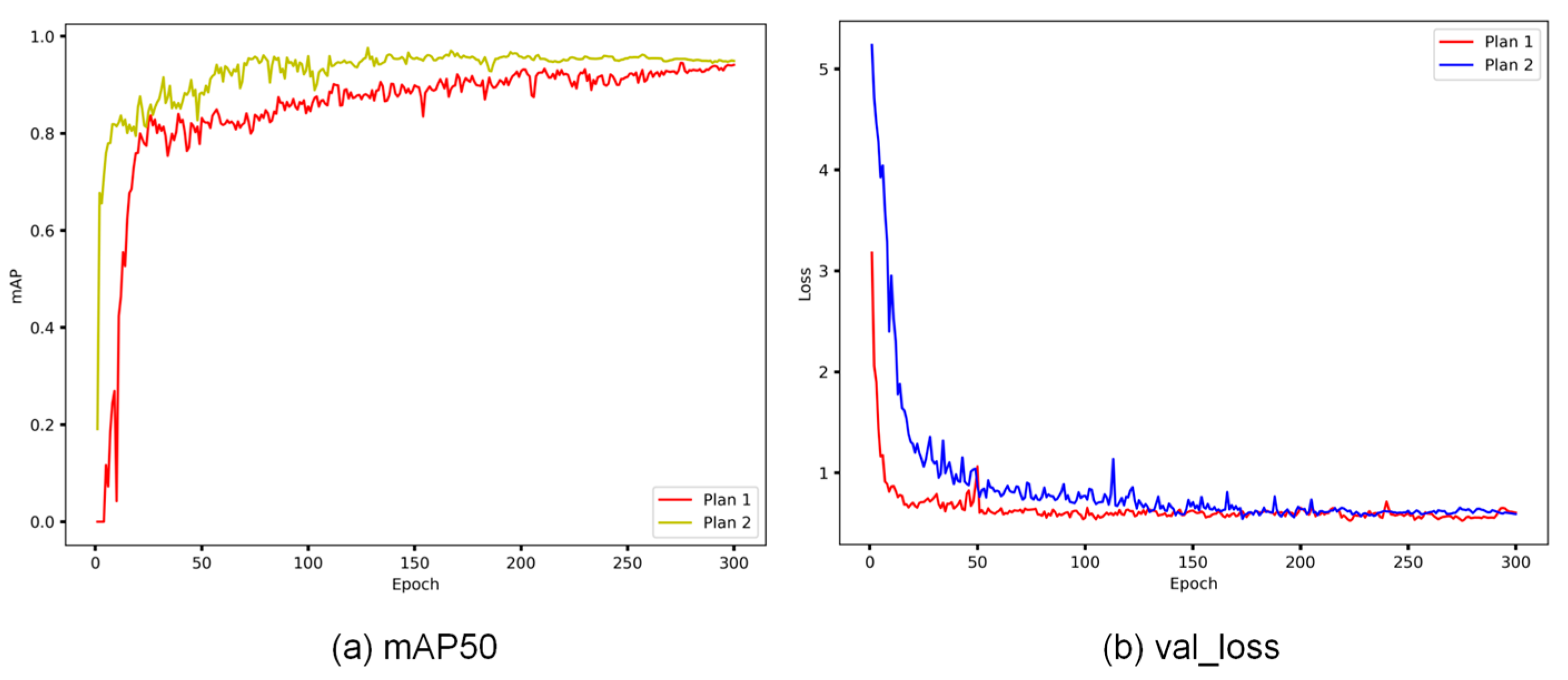
| Set No. | Number of Valves | Valve Category | Dataset Size |
|---|---|---|---|
| 1 | 4 | 2 | 277 |
| 2 | 6 | 1 | 246 |
| No. | Class | MRE | AP | P(FP) | P(FN) |
|---|---|---|---|---|---|
| 1 | Handwheel | 6.02% | 0.995 | 4.06 × 10−3 | 2.03 × 10−3 |
| 2 | Lever | 11.01% | 0.975 | 6.09 × 10−3 | 8.13 × 10−3 |
| 3 | Knob | 8.21% | 0.981 | 6.83 × 10−3 | 7.75 × 10−3 |
| Class | AP | P(FP) | P(FN) |
|---|---|---|---|
| knob1 | 0.979 | 7.17 × 10−3 | 8.66 × 10−3 |
| knob2 | 0.982 | 5.46 × 10−3 | 4.10 × 10−3 |
| Class | AP | P(FP) | P(FN) |
|---|---|---|---|
| knob1 | 0.975 | 8.11 × 10−3 | 9.32 × 10−3 |
| knob2 | 0.980 | 5.66 × 10−3 | 4.22 × 10−3 |
| Method | Precision | Recall | mAP50 |
|---|---|---|---|
| YOLOv9e OBB model | 0.925 | 0.956 | 0.967 |
| YOLOv8x OBB model | 0.929 | 0.976 | 0.944 |
| YOLOv8n OBB model | 0.966 | 0.972 | 0.968 |
| Proposed model | 0.975 | 0.989 | 0.979 |
Disclaimer/Publisher’s Note: The statements, opinions and data contained in all publications are solely those of the individual author(s) and contributor(s) and not of MDPI and/or the editor(s). MDPI and/or the editor(s) disclaim responsibility for any injury to people or property resulting from any ideas, methods, instructions or products referred to in the content. |
© 2024 by the authors. Licensee MDPI, Basel, Switzerland. This article is an open access article distributed under the terms and conditions of the Creative Commons Attribution (CC BY) license (https://creativecommons.org/licenses/by/4.0/).
Share and Cite
Zhang, Z.; Zhou, Q.; Jin, H.; Li, Q.; Dai, Y. A Real-Time Intelligent Valve Monitoring Approach through Cameras Based on Computer Vision Methods. Sensors 2024, 24, 5337. https://doi.org/10.3390/s24165337
Zhang Z, Zhou Q, Jin H, Li Q, Dai Y. A Real-Time Intelligent Valve Monitoring Approach through Cameras Based on Computer Vision Methods. Sensors. 2024; 24(16):5337. https://doi.org/10.3390/s24165337
Chicago/Turabian StyleZhang, Zihui, Qiyuan Zhou, Heping Jin, Qian Li, and Yiyang Dai. 2024. "A Real-Time Intelligent Valve Monitoring Approach through Cameras Based on Computer Vision Methods" Sensors 24, no. 16: 5337. https://doi.org/10.3390/s24165337
APA StyleZhang, Z., Zhou, Q., Jin, H., Li, Q., & Dai, Y. (2024). A Real-Time Intelligent Valve Monitoring Approach through Cameras Based on Computer Vision Methods. Sensors, 24(16), 5337. https://doi.org/10.3390/s24165337







